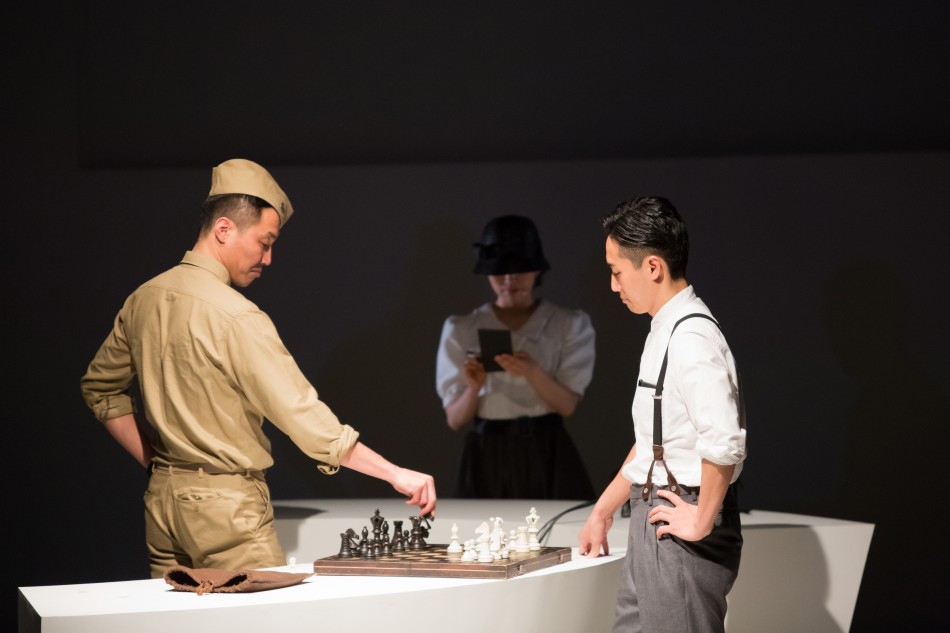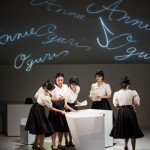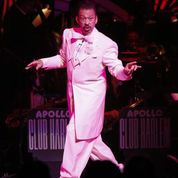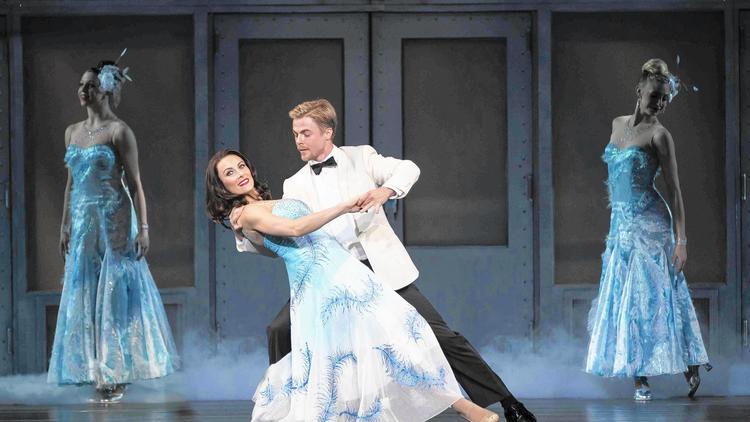by: Samuel L. Leiter
Few stories coming out of World War II are as compelling as that concerning the semi-mythical Tokyo Rose. The circumstances cry out for dramatization, and are the inspiration for the uninspiring Zero Hour: Tokyo Rose’s Last Tape conceived, written, and directed by Miwa Yanagi. This work, which originated in Japan, was given three performances at the Japan Society this weekend in honor of the seventieth anniversary of the war’s end.
Although no Tokyo Rose ever existed, the name emerged as a popular catch-all for the group of Japanese-American female broadcasters who, during the war, offered chatter and musical entertainment to the Pacific forces. When the war ended, the broadcaster tagged as Tokyo Rose was Iva Ikuko Toguri D’AquinoIva (1916-2006). This Los Angeles-born American, a graduate of UCLA, had gone to Japan to help an ailing aunt only to be trapped there after Pearl Harbor. Needing to earn a living (she could barely speak Japanese) she was forced to take employment as a typist for the state-run Radio Tokyo.
This evolved into Iva’s becoming one of a team intended to broadcast propaganda to the troops. In fact, she, and the POW radio pros who wrote her material, slyly subverted whatever innocuous commentary she had to read. She called herself Orphan Ann when broadcasting on the “Zero Hour” program, but, after the war, Iva—who needed money to leave Japan and had no idea that anything she’d done was actionable—was induced by two journalists to sign the name Tokyo Rose to a lucrative contract for an exclusive interview. This came back to haunt her when she was accused of treason and thrown in Sugamo Prison.
Back in the States, with the Cold War heating up under the newly elected Truman, she was tried and convicted as a traitor in a case that has been shown to be a sham. She lost her citizenship and spent six years of her ten-year sentence in prison. In 1977, President Ford pardoned her and restored her citizenship.
The mesmerizing story, filled with journalistic betrayal, right-wing hysteria, media distortions, political expediency, and judicial bias, has been told in nearly half-a-dozen books. Yanagi, known mainly as a visual artist, tells it in scattershot fashion, adding fictional characters, moving erratically around in time, and leaving out many crucial details. And, to pick a nit, the non-Japanese names aren’t always correct. For example, Maj. Charles Hughes Cousens, the POW writer of the “Zero Hour,” is called Maj. Carson, which could be a question of transliteration, while, for no apparent reason, Iva Ikuko Oguri D’Aquino is Anglicized as Annie Yukuko Oguri Moreno. (Oddly, aside from a typo, the Japanese script gets Iva’s entire name correctly.)
The broadcasters are played by an undifferentiated group of five pretty young women (Iva is played by Hinako Arao), who serve as a dancing-speaking chorus, moving the white, modernistic set’s modular units into different formations as the scenes change. Yanagi once did a photo series called “Elevator Girls;” if you’re familiar with this Japanese department store phenomenon, that’s what the women, who often bow formally with robotic precision, resemble in their cloche hats, white blouses, and black skirts, designed by Yukari Asakura. The actual broadcasters were unglamorous (according to Iva herself) and would never have bowed or dressed like this.
Yanagi aims for a highly formalized, even metaphoric presentation, much of it told through the contrasting views on the events by Japanese-American communications expert Daniel Yamada (Yohei Matsukado) and radio technician Toshiya Shiomi (Sogo Nishikawa). Their opposition—based on a blurry, uninvolving storyline about the identification of Tokyo Rose’s voice—is symbolized by their chess matches over many years. Such thematic dramaturgy is exemplified in the women’s choreographic movements, but the play also includes many scenes of straightforward dramaturgy, with the characters moving back and forth from Japanese to English. The dramatic narrative too frequently becomes secondary to the manner of its telling.
Still, the production falters seriously because of the lack of discernible acting talent (including that of the prerecorded American voices); dialogue that’s barely audible; fuzzily white subtitles on a white background that are mostly illegible; scratchy, incomprehensible recorded voices; a reductionist version of Iva’s trial; a snail-like pace; and a ponderous air of pretension. Zero Hour requires nearly two intermissionless hours but they still add up to zero.
P.S. Iva’s voice hasn’t “disappeared into the waves of history,” as Yanagi’s program note might suggest. While the production uses a fabricated recorded voice for her, those interested in hearing her actual voice, as well as seeing her, and pondering the reality behind the myth can easily find her on YouTube; there’s even a video in which she recreates a broadcast.
Zero Hour: Tokyo Rose’s Last Tape
Japan Society
333 E. 47th Street, NYC
3 performances only
*Photos:Ayumi Sakamoto.
























